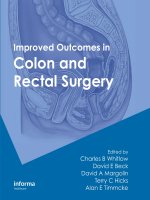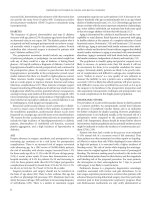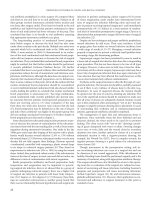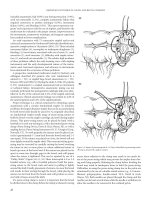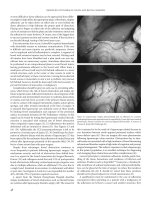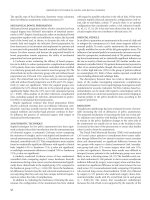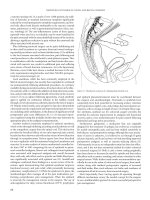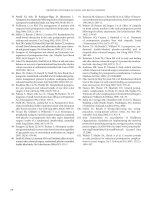Improved Outcomes in Colon and Rectal Surgery part 43 ppt
Bạn đang xem bản rút gọn của tài liệu. Xem và tải ngay bản đầy đủ của tài liệu tại đây (79.85 KB, 10 trang )
index
vs placebo 205–6
vs sphincterotomy 206
calcium channel antagonists 203–5
medical therapy 201
nitrates 201–3
randomized controlled trial
botulinum toxin 205
calcium channel antagonists 204
complications of 208–10
surgical therapy 206–8
anal dilation 207
refractory fissures 208
sphincterotomy 207–8
chronic constipation see constipation
chronic diverticulitis 254
surgical treatment 254
best timing 254
vs medical treatment 254
chronic pilonidal disease
surgical therapy 216
see also pilonidal disease
Ciprofloxacin 337
cisapride 73
Citrucel® 179
clean intermittent catheterization (CIC) 401
cleft lift procedure 220
Cleveland Clinic Florida 247
Clinical Outcomes of Surgical Therapy (COST) trial 59, 140
Clopidogel 135
Clostridium difficile 103
cocaine 19
Cochrane Database Review 28
Colazal 337
colchicine 367
colectomy 370
colocolic intussusception 115
colon cancer 322
colon injury
abdominal injury 376–8
anastomosis 380
diversion 378–80
meta-analyses investigation 380
primary repair 378, 379, 380
arguments of 378
randomized trials investigation 379
resection 379–80
colonic inertia see slow-transit constipation
colonic transit studies 362–3
radiopaque marker test 363
scintigraphic technique 363–4
colonic transit studies 93
colonoscopy 132
perforation rage 136
sedation 133
colorectal cancer 105–7
diverticulitis
detection and differentiation 105
metastasis 106
postoperative complications 107
recurrence 106–7
staging 105–6
Colorectal Quality Measures 165
colorectal transit 117
colostomy closure
outcomes of 384
colostomy 234, 375
colovesical fistula 396
Commission on Cancer (CoC) Joint Quality Measures 165
complex diverticulitis 255
complex perineal injury 389–90
computed tomography 390
pelvic fracture 390
computed tomographic colonography (CTC) 110–12
advanced adenoma 110–11
benefits 111
complications 111
limitations 111–12
optical colonoscopy 112
postoperative surgery 112
technique 111
computed tomography (CT scan) 99
appendix 108
bowel trauma 101–2
cecal volvulus 109
colitides 103–4
colorectal cancer 105–8
contrast enhanced multidector CT 100
diverticulitis 104–5
inflammatory bowel disease (IBD) 102–3
pneumatosis 100
pneumoperitoneum 100–1
sigmoid volvulus 109
small bowel obstruction
CT enteroclysis 110
diagnosis and causes 109–10
ischemia 110
paralytic/adynamic ileus 110
tumors 108–9
unenhanced multidector CT 99–100
Condyloma Acuminatum 155
condyloma 155
congestive heart failure 5
conservative therapy 200
acute anal fissure 200
constipation 361
balloon expulsion test 94
biofeedback therapy 367–8
biofeedback 94
colectomy, successful outcomes 370
colonic transit studies 362–4
colonic transit studies 93
complications 370
defecography 93
limitations 93
drugs associated with 362
functional constipation 361
initial evaluation 362
medical condition 361
medical treatment 365–7
high-fiber diet 365
medications 366
stimulant laxatives 367
MRI 94
limitations 94
pelvic floor physiology tests 364
Rome III diagnostic criteria 361
index
routine evaluation 362
small bowel transit 94
surgical intervention 368–70
timing 369
treatment 361
Contigen® 233
continent ileostomy 351
proctocolectomy with 320–2
Coronary Artery Revascularization Prophylaxis (CARP) 4
corticosteroids 337
cramping 367
Crohn’s disease
after surgery
health-related quality of life (HRQL) 344
postoperative occurrence 343
clinical features 331
computed tomography (CT scan) 102
evaluations of
blood test 332
double balloon enteroscopy (DBE) 335
imaging techniques 332–5
PET scan 335–6
stool marker 332
fever 331
and indeterminate Colitis 327
medical therapy 336
5-Aminosalicylates (5-ASA) 336–7
antibiotics 337
biologic response modifiers 338
corticosteroids 337
immunomodulators 337–8
postoperative recurrence, prevention of 338–9
nutritional therapy 339
surgical intervention
bypass surgery 343
resection 342–3
stricture biopsy 342
strictureplasty 341–2
surgical treatment
abscess 340
bleeding 341
indications for 339
obstruction 341
perforation 339–40
perianal crohn’s disease 340–1
toxic megacolon 341
symptoms of 331
cryotherapy 155, 291
CT enteroclysis 110
cyclosporine 338
damage control surgery (DCS) 381–2
damage-control laparotomy 46–7, 47
deep venous thrombosis (DVT) 71–2
defecography 93, 117, 240, 364
in constipation, limitations of 93
scintigraphic 363–4
dehiscence 324–5
delayed bladder injury 396
delayed hemorrhage 135
Delorme’s procedure 241, 242–3
Denonvilliers’ fascia 267
Depositions 151
destructive injury 389
detrusor function 401
devascularization injury 398
diabetes 8
diagnostic laparoscopy 387
diagnostic peritoneal lavage (DPL) 376
dietary modification 178
Dipentum 337
Diprivan 133
diverticular disease
immunosuppressed patients 254–5
incidence of 250
intra-operative classification 250
nonoperative therapy 250@
operative therapy 249, 255–7
complications of 257
Hartmann reversal 256–8
postoperative resection 258–9
procedures of 258–9
timing of closure 259
diverticulitis 143–4, 250
acute complicated 253
outcomes 253
recurrence, risk of 253
surgical intervention 253–4
chronic diverticulitis 254
complex diverticulitis 254
diverticulosis 250
acute uncomplicated 251
age 251–2
outcomes 251
progression, of disease 251
recurrence, risk of 252
postoperative surgery 258–9
procedures 258
diverting ostomies 352
Donabedian model 160
double balloon enteroscopy (DBE) 335
doxycycline 157
Duke Activity Status Index 4
duodenum stricture 343
Dutch Echocardiographic Cardiac Risk Evaluation Applying Stress
Echocardiography (DECREASE-V) 4
DVT prophylaxis 22
DVT see deep venous thrombosis (DVT)
dynamic graciloplasty 231–2
dysplasia 326
E. Coli see Escherichia coli
Eastern Cooperative Oncology Group (ECOG) 304
elective colectomy 258
elective colon resections 14
electomyography
in fecal incontinence with limitations 91
electrocardiogram 4
preoperative baseline 4
electrolyte 15
electromyography (EMG) 364
concentric needle 89–90
rectal prolapse 239–40
single fiber 90
surface 90
Elsberg syndrome 157
index
Emergency Department 249
end ileostomy 351
end ostomies 350–1
endometriosis 115
endorectal advancement flap 340
endoscopic ablation therapy 314
endoscopic ultrasound (EUS) 335
enterovesical fistula 396, 397
EORTC 310
epidural anesthetic 21–2
ERBITUX® 301
erythema 28
erythromycin 73
Escherichia coli 14, 386
evisceration 283
excisional hemorrhoidectomy 169–72
extrasphincteric fistulas 186
fecal bolus 227
fecal contamination 282–3
fecal continence 87
fecal incontinence, surgery for 87, 174
biofeedback 92
limitations 92
electromyography, limitations 91
manometry 87–8, 88
limitations 89
ultrasound, limitations 92
anorectal physiology tests (ARP) 228–9
epidemiology 226
etiology
anal sphincter 226
central nervous system 227
fecal bolus 227
rectum 226–7
evaluation
historical 227–8
physical 228
severity, assessment of 227
risk factors 227
treatment
antegrade colonic enema 233
artificial bowel sphincter 231
biofeedback 229
dynamic graciloplasty 231–2
injectable bulking agents (IBA) 233
medical therapy 229
sacral nerve stimulation 232–3
sphincteroplasty 229–31
fentanyl 21, 133
Ferguson hemorrhoidectomy 170, 171
FFCF trial 310
FiberChoice® 179
Fibercon® 179
fibrin glue 187–8
Fibrin Glue 340
fibrinclot 340
fissures see anal fissures
fistula 174, 219, 340
fistula-in-ano
carcinoma associated with 193
classifications 184
fistulotomy 186, 340
flexion distraction injury 376
Flint grade 378
fluoroscopy 112–17
barium enema 112–15
physiologic examinations 117
anorectal manometry 117
balloon proctography 117
colorectal transit 117
defecography 117
water-soluble contrast enema 115–17
focused abdominal sonography for trauma (FAST) 376–7
evaluation 376
FOLFIRI 301
FOLFOX 300
Frykman-Goldberg procedure 245–6
functional constipation 361
see also constipation
gabapentin 68
gastrointestinal (GI) bleeding 122
gastrointestinal obstruction 341
gastrointestinal scintigraphy 121–2
Gastrointestinal Tumor Study Group and North Central Cancer
Treatment Group 308
Gatrointestinal Stroma Tumors (GIST) 109
German Rectal Cancer Trial 302
glyceryl trinitrate (GTN) 200, 202
Goldman risk model 3
gracilis transposition 341
Hand Assisted Laparoscopic (HAL) Colectomy 255
Harmonic Scalpel® hemorrhoidectomy 172
Harmonic Scalpel® 172
Hartmann colostomy
outcomes of 256
reversal 256–7
healthcare 263
Heineke–Mikulicz procedure 341
hemorrhage 134–5, 281
anastomosis 41
delayed bleeding 174
intraoperative 281
intraoperative 44–6
postoperative bleeding 173–4
postoperative 281–2
hemorrhoid
anatomy and pathophysiology 178
bleeding 178
classifications 181
clinical evaluation 178
grading system 178
nonoperative therapy for 178
techniques, comparison of 181–2
treatment
conservative management 178–9
infrared photocoagulation 181
rubber band ligation 179–80
sclerotherapy 179
hemorrhoidal surgery 168
anatomy/etiology 168–9
clinical evaluation 169
excisional hemorrhoidectomy 169–72
nonexcisional options 169
index
postoperative complications
anal fistula 174
anal stenosis 174
anal tags 175
constipation and fecal impaction 174
fecal incontinence 174
hemorrhage 173–4
infection 174
mucosal ectropion 174
pain 172
urinary retention 172–3
sagical section and anal cushion 168
special situation
anorectal varices 175
postpartum hemorrhoids 175
heparin 22
hepatic artery infusional (HAI) therapy 290–1
hepatic disease 6
hepatic metastasis, chemoembolization of 123
herpes simplex virus (HSV) 156–7
hidradenitis suppurativa 215
diagnosis 222
nonoperative management 222–3
pathophysiology 221–2
surgical management
excision 223
high-molecular-weight polyethylene glycol (PEG) 366–7
HIV/AIDS 7
human immunodeficiency virus 156
human papillomavirus (HPV) 155
hydrocortisone cream 155
hyperbaric local anesthetic 21
hyperbaric oxygen 314
hypercoaguable syndromes 9
hypersomolar oral saline laxative 15
hypertonic NaP 15
hypobaric local anesthetics 21
iatrogenic injury 266
iatrogenic perforation 144
iatrogenic ureteral injuries 397
distal one third 398–9
middle one third 398
proximal one third 398
idiopathic hypertrophic subaortic stenosis (IHSS) 22
IFL 301
ileal pouch-anal anastomosis (IPAA) 325, 351
ileal-rectal anastomosis (IRA) 351
ileocolic resection 342
ileocoloc intussusception 110, 115
ileonal pouch procedure
abdominal colectomy 322
complications 323–326
controversies 326–7
functional result 323
proctocolectomy 319–23
ileorectal anastomosis
with abdominal colectomy 322
ileostomy 352
selective omission 327
ilioinguinal and iliohypogastric nerve block 23
image-guided percutaneous biopsy 123
imaging studies 97
abdominalradiography 97–99
bowel obstruction and dilatation 97–8
cecal volvulus 99
pneumoperitoneum 97
sigmoid volvulus 98–9
toxic megacolon 98
computed tomographic colonography (CTC) 110–12
advanced adenoma 110–11
benefits 111
complications 111
limitations 111–12
optical colonoscopy 112
postoperative surgery 112
technique 111
computed tomography (CT scan) 99
appendix 108
bowel trauma 101–2
cecal volvulus 109
colitides 103–4
colorectal cancer 105–8
contrast enhanced multidector CT 100
diverticulitis 104–5
inflammatory bowel disease (IBD) 102–3
pneumatosis 100
pneumoperitoneum 100–1
sigmoid volvulus 109
small bowel obstruction 109–10
tumors 108–9
unenhanced multidector CT 99–100
fluoroscopy 112–17
barium enema 112–15
physiologic examinations 117
water-soluble contrast enema 115–17
interventional radiology 122–3
chemoembolization of hepatic metastasis 123
gastrointestinal (GI) bleeding 122
image-guided percutaneous biopsy 123
percutaneous abscess drainage (PAD) 122–3
radiofrequency ablation (RFA) 123
magnetic resonance imaging (MRI) 119–20
nuclear medicine imaging
gastrointestinal scintigraphy 121–2
positron emission tomography 120–1
ultrasonography 117–19
endoluminal ultrasound’s (EUS) 119
intraoperative ultrasound 119
transabdominal ultrasound 118
imaging techniques
in crohn’s disease
colonoscopy 334
computed tomography scan 334–5
double balloon enteroscopy (DBE) 335
endoscopic ultrasound (EUS) 335
enema 332
magnetic resonance imaging 335
scintigraphy 336
small bowel series 332
transabdominal ultrasound (US) 334
upper edoscopy 332–3
imiquimod 156
immunocompromise 7
immunomodulators 337–8
immunosuppressed patients 254–5
index
impaired sensorium 5
infections 69–70
surgical site 69–70
urinary tract infections 70
inflatable penile prosthesis (IPP)
components 402
Infliximab 193, 338
infrared photocoagulation 181
injectable bulking agents 233
injection sclerotherapy 179
interventional radiology 122–3
gastrointestinal (GI) bleeding 122
hepatic metastasis, chemoembolization of 123
image-guided percutaneous biopsy 123
percutaneous abscess drainage (PAD) 122–3
radiofrequency ablation (RFA) 123
intestinal stomas 349
intraabdominal hemorrhage 323–4
intraabdominal infections 29
percutaneous drainage 29
intraoperative anastomosis 33
case management 33
challenges 40–1
adjuvants and drains 41
hemorrhage 41
inadequate anastomotic lumen 40–1
leakage 41
proximal protection 41
preanastomotic considerations
bowel preparation 33–4
bowel status 34
exposure 34
obtaining adequate length 35–6
operative principles 33
preoperative discussion and planning 33
staples versus sutures 37
double staple 39
end-to-end 37–9
end-to-side 39–40
side-to-side 39–40
technique 36–7
test 40
types of 37
intraoperative challenges 44
abdominal wall closure 51
adhesive disease 47–9
biologic meshes 52
case management 44
damage control 46–7, 47
hemorrhage 44–6
lesion localization 49–50
preoperative evaluation 44
retention sutures 51
suture material 51
synthetic prostheses 51–2
technique 51
intraoperative positioning
lateral decubitus 24
lithotomy 24
nerves, at risk 24
prone 23–4
supine 23
intraoperative radiation therapy (IORT) 287
intraperitoneal anastomoses 29
intrathecal blockade see spinal blockade
intravenous antibiotics 15
effect of 15
inulin 179
IPAA 322
Irinotecan 303
IROX 301
ischemia 353
isobaric local anesthetics 21
isosorbide dinitrate (IDN) 200
isosorbide mononitrate (IMN) 200
Ivalalon sponge rectopexy 244, 245
jeep disease 215
Kaposi’s sarcoma 156
Karydakis flap 200
Klebsiella 386
Kock pouch 322
Konsyl® 179
laceration injury 398
lactulose 366
laparoscopic colorectal surgery 140
advantages 140–1
colonoscopic perforation 144
disadvantages 141
diverticulitis 143–4
inflammatory bowel disease
ulcerative colitis 142–3
instruments 145
purported benefits 140
rectal prolapse 144
stoma 143
technical considerations 144
treatable conditions
colon cancer 141–2
trocar placement 144–5
vascular control 145
laparoscopic intraperitoneal surgery 4
laparoscopic surgery 28
laparoscopy 246, 291–2, 377
lateral decubitus positioning 24
lateral fistula 216–16
Leapfrog Group 160–1
criteria 161
purchasing principles 160–1
Lee index 3
leucovorin 300
levamisole 300
lidocaine 19
life-threatening injuries 389
LigaSure™ Vessel Sealing System 291
LigaSure™ 172
Ligation of Intersphincteric Fistula Tract
(LIFT) 189
linaclotide 367
liposuction 357–8
lithotomy 389
positioning 24
litigation injury 398
liver metastasis 289
index
adjuvant therapy 291
assessing resectability 289–91
operative approach
laparoscopy 291–2
open resection 292
outcomes 292
treatment of 289
local anesthesia 19, 389
drugs 19
perianal block 20
relative potency 19
systemic toxicity 20
loop end stomas 351–2
loop ileostomy 327
loop ostomies 352
loose hair 215
Lovenox® 135
low-molecular weight heparin (LMWH) 22
lubiprostone 367
lung metastasis 292
assessing resectability 293
operative approach 294
outcomes 294–5
treatment of 292
video assisted thoracoscopic surgery (VATS) 294
magnetic resonance imaging (MRI) 94, 119–20
in constipation, limitations of 94
malignancy 326
malnutrition 6–7
mannitol 15
manometry 87–8, 88
for incontinence
value and limitations of 89
marsupialization 218
mechanical bowel preparation (MBP) 15, 16
randomized controlled trials 16–17, 28
Meckel’s diverticulum 104
medical legal issues 148
affordable liability insurance, lack of 148–9
documentation
chart 150
high-risk areas 149
informed consent 149–50
malpractice suit, anatomy of
initial phase 150–1
ploys 150–2
pretrial discovery 151
testing your memory 151
trials 152
physician-patient relationship 149
medical therapy
chronic anal fissure 199–6
fecal incontinence 229
melanosis coli 367
meperidine 133
mepivacaine 19
mesh rectopexy 243
mesh sling repair 244
metabolic disease 7
Metamucil® 179
methotrexate 338
Methylcellulose 179
Metronidazole 337
microfibrillar collagen 266
midazolam 133
Milligan-Morgan hemorrhoidectomy 169–70, 171
misoprostol 367
modified abdominoplasty 356–7
flap dissection 356, 357
caring 356–7
Monitored Anesthetic Care (MAC) 20–1
morbid obesity 355–8
preoperative stoma marking 356
preoperative weight loss 356
mucosal ectropion 174
mucosectomy
vs. double-stapled technique 326–7
multidector computed tomography (MCDT) 99–110
see also computed tomography
National Healthcare Safety Network (NHSN) 27
National Cancer Institute (NCI) 165
National Comprehensive Cancer Network (NCCN) 165, 290
National Initiative on Cancer Care Quality (NICCQ) 164
National Nosocomial Infections Surveillance (NNIS) System 27
National Quality Forum (NQF) 164, 165
National Surgery Quality Improvement Project
(NSQIP) 3, 162
National VA Surgical Risk Study (NVASRS) 162
nausea 72
neisseria gonorrhea 157
neoadjuvant chemoradiotherapy 302
tumors 302
nephropexy 398
neurologic system 8–9
Parkinson’s disease 8–9
neutropenic colitis 104
Nichols-Condon antibiotic 14
nifedipine ointment 204
nipple valve slippage
manifestations of 322
nitrates 200, 201–3
vs calcium channel antagonists 204
sphincterotomy 203
nitroglycerin (NTG) 200
nitroglycerin transdermal patch 200
NJ 135
node-positive rectal cancer 302–3
neoadjuvant chemoradiotherapy for 302
T3
adjuvant chemotherapy alone for 302–3
nonabsorbable disaccharides 366
nonbladed trocars 145
noncutting Seton 340
nuclear medicine imaging
gastrointestinal scintigraphy 121–2
positron emission tomography 120–1
obesity 7–8
olsalazine 337
omentoplasty 283
open abdominal repairs 244
oral antibiotic prophylaxis 28
Oral antibiotics 14
oral lavage 133
index
oral preparations 15
polyethylene glycol (PEG) 15
sodium phosphate (NaP) 15
ostomy
complications with
ischemia 353
morbid obesity 355–8
parastomal hernias 354–5
prolapse 355
retraction 353
skin 353
stenosis 353–4
dissected free 357
preoperative stoma marking 350
psychological impact 349–50
reversal 358
types of 350–3
ostomy necrosis 353
outcome measures 161–5
and quality measures 165
overlapping sphincteroplasty 230
Oxaliplatin 303
pain management 67–8
paralytic ileus 110
parastomal hernias 354–5
parenteral antibiotic prophylaxis 14
Parkinson’s disease 8–9
patient-controlled epidural analgesia
(PCEA) 21
pectins 179
pelvic floor dysfunction 361
biofeedback therapy 367–8
and slow-transit constipation 362
pelvic floor physiology tests
anorectal manometry 364
balloon expulsion test 364
defecography 364
electromyography (EMG) 364
pelvic hemorrhage 266
pelvic kidneys 400
pelvic nerve 401
pelvic sepsis 29–30, 389–90
manifestations 324
penetrating colon injury
damage control surgery (DCS) 381–2
penetrating colon injury 380–1
practice patterns 382
primary repair versus diversion
arguments of 378–80
meta-analyses investigation 380
randomized trials investigation 379
penicillin G 157
percutaneous abscess drainage
(PAD) 122–3
perianal crohn’s disease
elective surgery 340
surgical treatment 340
perineal hernia 283
perineal proctosigmoidectomy 241–2
perineal rectosigmoidectomy 240
perineal sinus 282
perineal wound complications 282
perirectal abscesses
Crohn’s disease 192
diagnosis 184–5
etiology 183–4
HIV-positive patient 193
incontinence 190–2
non-surgical management 192–3
recurrence 189–90
surgical therapy
advancement flap 186–7
anal fistula plug 188–9
extrasphincteric fistulas 186
fibrin glue 187–8
fistulotomy 186
incision and drainage 185–6
seton placement 186
PET scan see positron emission tomography scan 335–6
phenol sclerotherapy 217
Physician Quality Reporting Initiative (PQRI) 161, 163–4
Physiologic and Operative Severity Score for enUmeration of Mortality
and morbidity (POSSUM) 2, 257
pilonidal disease 215
acute disease 216
advanced procedures for 220
Bascom operation 219
chronic disease 216
chronic pilonidal disease 217
diagnosis 215–16
historical perspective 215
limited excision 219
marsupialization 218–19
nonhealing wounds 220
nonsurgical treatment 216–17
phenol sclerotherapy 217
procedures for 217
sacral wound 220
surgery for 219–20
wide local excision 217–18
plain films 97
Plavi® 135
Plavix 8
pneumonia 71
pneumoperitoneum 97
abdominalradiography 97
computed tomography (CT scan) 100–1
podophyllin 155–6
polyethylene glycol (PEG) 15
polyethylene glycol electrolyte lavage solution (PEG-ELS) 366
polypectomy 135
polyvinyl alcohol sponge rectopexy 244, 245
positron emission tomography (PET) scan 120–1, 335–6
positron emission tomography with fluorine 18–labeled fluoro-2-
deoxy-D-glucose (FDG-PET) 335–6
Post Dural Puncture Headache (PDPH) 22
posterior bladder injury 396
posterior mesh fixation 244
posthemorrhoidectomy pain 172
postoperative complications 67
atelectasis
pneumonia 71
prevention 71
bleeding 69
case management 67
index
deep venous thrombosis 71–2
infections
surgical site 69–70
urinary tract 70
nausea and vomiting 72
pain 67–8
prolonged ileus 72–3
retained foreign bodies 73–5
time out” and sided surgery concerns 75
urinary retention 70–71
postoperative hemorrhage 323–4
postoperative ileus 140
postoperative patient
pelvic sepsis 29–30
with sepsis 27
postoperative pneumonia 25
postoperative pulmonary complications (PPCs) 5
postpartum hemorrhoids 175
postpolypectomy bleeding 135
anticoagulant recommendations 135
management of 134
pouch anal fistulas 325
pouch vaginal fistulas 325
pouchitis 322, 326
prednisone 337
premenopausal females 2
preoperative bowel preparation 14
in elective colon resections 14
objectives 14
preoperative cardiac disease 3–4
ACC 4
hypertension 3
preoperative medical condition 1
aging 8
anesthesia consultation 1
cardiovascular disease 3–4
diabetes 8
documentation 3
hepatic disease 6
HIV/AIDS 7
hypercoaguable disorders 9
immuncompromise 7
malnutrition 6–7
metabolic disease 7
neurologic system 8–9
obesity 7
premenopausal females 2
prevent postoperative complications 1
pulmonary disease 5
renal disease 5–6
using scoring systems 2
preoperative risk assessment
scoring systems 2
prilocaine 19
Priritis ani 154
causes of 154–5
measures 155
soilage 154
procaine 19
procedure for prolapse and hemorrhoids (PPH) 172, 173
proctectomy
fecal contamination 282–3
proctitis 157
proctocolectomy
with brooke ileostomy
indications 319–20
operative technique 320
outcomes 320
with continent ileostomy
operative technique 320
outcomes 320–2
with ileoanal pouch 322
indications 322
operative technique 322–3
outcome 323
prolapse 355
prone positioning 23–4, 389
jack-knife position 21
prophylactic antibiotics 27
prophylactic sigmoid resection 255
pseudodiverticula 114
pseudomonal species 386
Psoas hitch 399
psuedomembranous colitis 103–4
psychiatric evaluation 23
psyllium 179
PTQ implants
TM
233
pulmonary disease 5
American College of Physicians 5
risk factors 5
purse-string stitch, repair of 38–9, 38
quality measures
assessment and improvement,
in surgery 159
process measures 161, 162, 163–4
structural measures 160–1
definition 159
Donabedian model 160
Leapfrog Group 160–1
criteria 161
purchasing principles 160–1
and outcome measures 165
radiation therapy 306
acute adverse effects 310–11
adjuvant treatment 307–10
chronic late adverse effect 312–13
chronic rectal effects 313–14
neoadjuvant treatment 308
surgical complications 311–12
radiofrequency ablation (RFA) 123
randomized controlled trials 16
mechanical bowel preparation (MBP) 15, 16
rapid plasma regain (RPR) 157
rectal carcinoma
staging 306
rectal injury
classic components of 387
foreign bodies 388
high-risk factors of 387
intraperitoneal injury 387–8
management of
fecal diversion 387
modified steps 388
traditional steps 388
index
rectal procidentia 239
rectal prolapse
abdominal fixation procedures 144
anal physiology 239–40
defecography 240
evaluation and investigations 239
operative procedures 240–1
anal encirclement 243–4
Delorme’s procedure 242–3
laparoscopic approach 246
mesh sling repair 244
open abdominal repairs 244
perineal proctosigmoidectomy 241
perineal repairs 241
posterior mesh fixation 244
resection rectopexy 245–6
suture rectopexy 244–5
physical exam 239
recurrent prolapse 246–7
surgery for
Recto-Anal inhibitory reflex (RAIR) 89
recurrent rectal cancer 286
assessing resectability 286
chemotherapy and radiation 287
operative treatment 287, 289
outcomes 288
refractory fissures 208
regional anesthesia 21–3
central neuraxial blockade 21–2
ilioinguinal and iliohypogastric
nerve block 23
Transversus Abdominis Plane
(TAP) block 22–3
renal disease 5–6
resection 379–80
resection rectopexy 245–6
restorative proctocolectomy 327
Cesarean sections 323
with ileoanal pouch 322
indications 322
operative technique 322–3
outcomes 323
retrograde urethrogram (RUG) 395
Rhomboid flap 200
Ripstein procedure 243, 244
RTOG 310
rubber band ligation 179–80
sacral foramina 232
sacral nerve stimulation (SNS) 232
efficacy of 232
functional result 233
indications for 232–3
selection criteria 232
sacral neuromodualtor 402
sacral wound healing 221
sacrococcygeal fascia 217, 220, 221
Sanofi-Aventic 135
scintigraphy 336
sclerotherapy 179
seat belt sign” 376
secretagogues 367
sedation 389
senna 367
sepsis 27
intraabdominal infections 28
pelvic sepsis 29–30
postoperative patient 27
surgical site infection 27–8
seton placement 186
severe diarrhea
postoperative radiation therapy 310
sexual dysfunction 323, 401–2
erection 402
male and female patients 401
modalities 402
short-chain fatty acids (SCFA) 314
sigmoid volvulus 98–9, 115
skin infection 27
skin 27
functions 27
wound infection 27
slow-transit constipation 361
and pelvic floor dysfunction 362
total abdominal colectomy
and ileorectal anastamosis 369
small bowel crohn’s disease
imaging techniques 336
small bowel obstruction
small bowel transit constipation 94
sodium phosphate (NaP) 15, 133
dosages 15
soft tissue infection 27
sorbitol 366
sphincteroplasty
fecal incontinence 229–30
functional result
follow-up 230
sphincterotomy 207
vs botulinum toxin (BT) 206
vs calcium antagonists 204
nitrates 203
spinal blockade 21
spirochete 157
splenic injury 266
recognition 266
SSI see surgical site infection (SSI)
Staphylococcus aureus 222
staple anastomosis
vs suture 37
double staple 39
double staple 39
double staple 39
double staple 39
end-to-end 37–9
end-to-side 39–40
vs sutures 37
stapled anoplasty 170, 173
stenosis 354
Z-plasty repair 352
stimulant laxatives 367
side effects 367
stoma necrosis 353–4
stomal retraction 357–8
index
stomas 143
living with 349–50
meshing 354
necrosis
conservative management 354
site marking 350
types
diverting ostomies 352
end ostomies 350–2
loop colostomy 352
stricture biopsy 342
stricture 265
strictureplasty 341–2
indication and contraindication 342
sucralfate 314
sulfasalazine 336
superficial injury 389
supine positioning 23
suprapubic catheter 401
Surgical Care Improvement Project (SCIP) 19, 161, 162
common and preventable complications 25
process and outcome measures 25
Surgical Infection Prevention Guideline Writers Workgroup
(SIPGWW) 14
surgical site infection (SSI) 27–8, 69–70
laparoscopic surgery 28
prophylactic antibiotics 27
scaling 27
skin and soft tissue infection 27
surgical therapy
abdominal surgery 264, 265–7
advancement flap 186–7
anal fistula plug 188–9
anal fistula 183, 186–7
chronic anal fissure 201–8
chronic diverticulitis 254
chronic pilonidal disease 216
Crohn’s disease 339–41
extrasphincteric fistulas 186
fecal incontinence 226
fibrin glue 187–8
fistulotomy 186
hidradenitis suppurativa 215
incision and drainage 185–6
perianal crohn’s disease 340
perirectal abscess 183, 185–9
pilonidal disease 217
seton placement 186
on stoma 354
Surgisis® 188
suture anastomosis
vs staple 37
double staple 39
end-to-end 37–9
side-to-side 39–40
vs sutures 37
suture rectopexy 244–5
laparoscopy 246
Swedish Rectal Cancer Trial 302
syphilis 157
systemic inflammatory response syndrome (SIRS) 27
Teflon® 233
Tegaserod 367
temperature and oxygenation 28
test-tube test” 353
tetracaine 19
therapeutic heparin 22
thermal injury 398
Thiersch repair 243–4
thiopurine methyltransferase (TPMT) 337–8
thrombin 266
tissue oxygenation 28
TissueLink Endo SH2.0™ Sealing Hook (SH) 291
total abdominal colectomy
with ileorectal anastamosis 369
total mesorectal excision (TME) 308, 401
toxic megacolon 98, 341
transabdominal ultrasound (US) 334
transanal approach, to rectal cancer
benefits 276
complications 275
imaging techniques 271–2
local surgery
disadvantages 276
oncologic advantages of 276
outcomes 276
surgical options 271–2
Transanal Endoscopic Microsurgery (TEM) 273
comparison with 275–6
complication of 275
techniques of 274–5
transanal excision 272
techniques 273
Transanal Endoscopic Microsurgery (TEM)
comparision with 275, 276–6
complication of 275
benefits 276
local surgery
disadvantages 276
oncologic advantages of 276
outcomes 276
and transanal 273, 275–6
techniques of 274–5
transanal endoscopy 132
colorectal preparation 132–4
hypertonic electrolyte solutions 133
infectious disease complications 134
intravenous sedation 133–4
oral lavage 133
nontechnical complications 132
postpolypectomy syndrome 136–7
proctoscopic perforations 137
technical complications
hemorrhage 134–5
perforation 135–6
transanal excision 272
transanal rectal flap advancement 396
transcoccygeal Kraske approach 278
transureteroureterostomy 399
Transversus Abdominis Plane (TAP) block 22–3
Trendelenburg position 23, 246
Treponema pallidum 157
trichloroacetic acid 155

